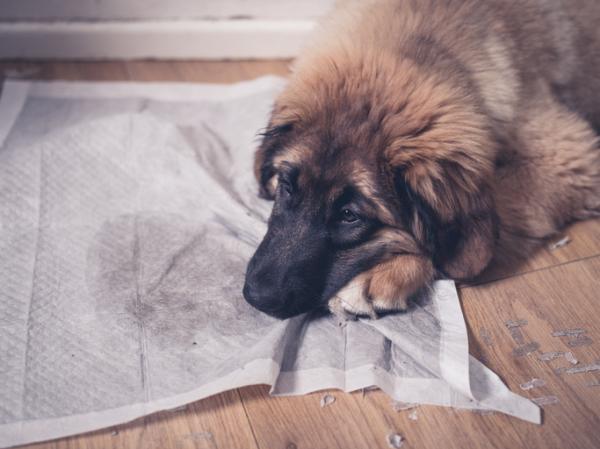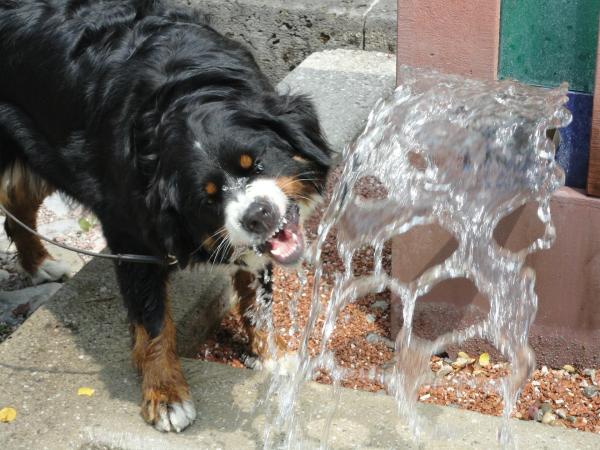
Canine cystitis is one of the most common conditions faced by dogs. Often, the initial symptoms may lead you to believe that your dog is just misbehaving and you may not pay enough attention to what is really going on. To prevent your dog's discomfort worsening, and to be able to initiate the best course of treatment as soon as possible, AnimalWised is here to explain all you need to know about how to treat cystitis in dogs.
Before looking at treatment, though, we will explain the main causes and symptoms of canine cystitis. As you will see, on occasion, inflammation actually signals that a more serious disease is developing. Remember that you should always consult a vet if your dog is sick, so that they can make a proper diagnosis and prescribe appropriate medication.
What is cystitis in dogs?
Just like with human cystitis, cystitis in dogs refers to the an infection that causes inflammation of the dog's urinary bladder. While many people associate this condition with urinary tract infections (UTIs), the two terms are not synonyms for the same disease. In fact, a UTI is just one of the possible causes that can lead to cystitis in dogs.
Infections that lead to canine cystitis are usually bacterial. There can also be other causes, which we will look at in the next section. Cystitis in dogs can be acute or chronic, and it can occur in dogs of all breeds and ages, from puppies to elderly dogs. How to treat cystitis in your dog will depend on factors such a recurrence and the dog's age and health condition.
What causes cystitis in dogs
In order to understand how cystitis is treated, we first have to look at causes. There are several causes that can lead to your dog suffering from cystitis. As we have mentioned, it is most often triggered by bacteria. The bacteria first lodge in the skin that lines the anus, then pass through the urethra until they reach the bladder. Once in the dog's bladder, they begin multiply, causing infection and subsequent inflammation.
In such cases, a urinary tract infection is the cause of cystitis. Veterinarians identify this type of cystitis as an ‘ascending infection’, as the bacteria travel upwards through the dog's urinary system. Occasionally, bacteria can also descend into the dog's bladder from infected kidneys or via the blood stream, though this is less common.
Studies carried out on dogs with bacterial cystitis reveal that the main bacteria causing the infection is usually Escherichia coli. There have also been cases of infection by Enterococcus spp and Pseudomonas spp, though these are fewer and more commonly infect dogs suffering from recurrent UTIs [1].
Since the female urethra is shorter than the male urethra in dogs, bitches are more likely to suffer from bacterial cystitis. Paying attention to anal hygiene, especially if you have a female dog, is particularly important when trying to prevent canine cystitis.
Although direct bacterial infection is the most common cause, there are other factors that can lead to or hasten the development of cystitis in dogs:
- Bladder stones: these can trigger an infection and inflammation.
- Tumors: urinary bladder cancer and chemotherapy can facilitate the development of urinary tract infections.
- Diabetes: canine diabetes expedites bacterial colonization of the urinary tract, due to the dog's high blood sugar levels.
- Drugs: some medications such as cortisone weaken a dog's immune system, which can aid the growth of bacteria in the urinary bladder.

Cystitis symptoms in dogs
Kidneys produce urine, which is stored in the bladder and later expelled via the urethra. When the walls of the urinary badder become inflamed, the organ's urine-storing capacity is drastically reduced. This causes the the dog to urinate smaller amounts and more often. Frequent urination and incontinence are some of the main symptoms of canine cystitis. You may be find that your furry friend urinates inside the house, even if they had never done so before. Another common symptom is hematuria, or the blood in the dog's urine. If your dog is peeing blood, cystitis is one of the possible causes, but there may be others. It is always best to consult a veterinarian if you notice this symptom.
Here are some other symptoms that suggest your dog may be suffering from canine cystitis:
- Hyperactivity: restlessness is often caused by the heightened need to urinate.
- Dysuria or pain: your dog may whimper or cry and show signs of pain while urinating.
- Straining: straining or discomfort while trying to urinate is another symptom of cystitis.
If you notice any of these symptoms (some of which, such as incontinence or hyperactivity, can be easily be mistaken for a bad behavior), take your dog to a veterinarian as soon as possible. The vet will be able to conduct the appropriate tests and choose the best course of treatment.
How to treat cystitis in dogs
Diagnosis of canine cystitis
When you take your dog to the vet, they will ask you to describe for each and every one of the symptoms that you have noticed. This is why it is important for you to pay close attention to your dog's behavior. The doctor will then take a urine sample from your dog for analysis. This will help them confirm canine cystitis and identify the underlying cause. The vet will then conduct an urine culture and sensitivity test to determine the bacteria present and the most effective treatment for eliminating them.
The vet may also perform an X-ray, ultrasound and an endoscopy to confirm the diagnosis of cystitis, especially if the underlying cause is related to bladder stones, polyps or tumors.
Treatment of cystitis in dogs
Treatment of bacterial cystitis in dogs is usually based on antibiotics. Antibiotics can only be prescribed by the vet and following a sensitivity or susceptibility test. Remember never to interrupt specialist-recommended treatment unless they tell you to. Especially in the case of antibiotics, interrupting the treatment before it has run its full course can cause the infection to resurface. The vet may also prescribe anti-inflammatory drugs to reduce the dog's pain and discomfort.
On your part, it is crucial to make sure your dog consumes enough water, as this will significantly facilitate its recovery. Drinking plenty of water helps the bladder flush out bacteria and it dilutes the urine, which will make urination less painful for your dog.
If your dog is suffering from bladder stones, tumors or diabetes, the vet will prescribe specific treatments to cure the cystitis while attending to the underlying disease as well. Treatment may involve a special diet or procedures to dissolve bladder stones and surgical intervention to remove polyps. If your dog has cystitis caused by tumors, radiation therapy may be required.

How to prevent cystitis in dogs?
As with most illnesses, prevention is the best cure when it comes to cystitis. To prevent cystitis in your dog it is fundamental that you stick to the dog's vaccination schedule and maintain proper anal hygiene. Especially if your dog is a female we recommend cleaning around the anus and vagina each time the dog defecates or urinates. This will prevent cystitis-causing bacteria from lodging in this area and travelling up to the bladder.
In addition, dehydration or insufficient waterintake can increase your dog's chances of suffering a UTI. Making sure that your dog drinks enough water is a good preventive measure against canine cystitis.

This article is purely informative. AnimalWised does not have the authority to prescribe any veterinary treatment or create a diagnosis. We invite you to take your pet to the veterinarian if they are suffering from any condition or pain.
If you want to read similar articles to How to Treat Cystitis in Dogs, we recommend you visit our Bacterial diseases category.
1. Thompson, M. F., et al. (2011). Canine bacterial urinary tract infections: New developments in old pathogens. The Veterinary Journal, 190(1). 22-27.
https://www.sciencedirect.com/science/article/pii/S1090023310004004